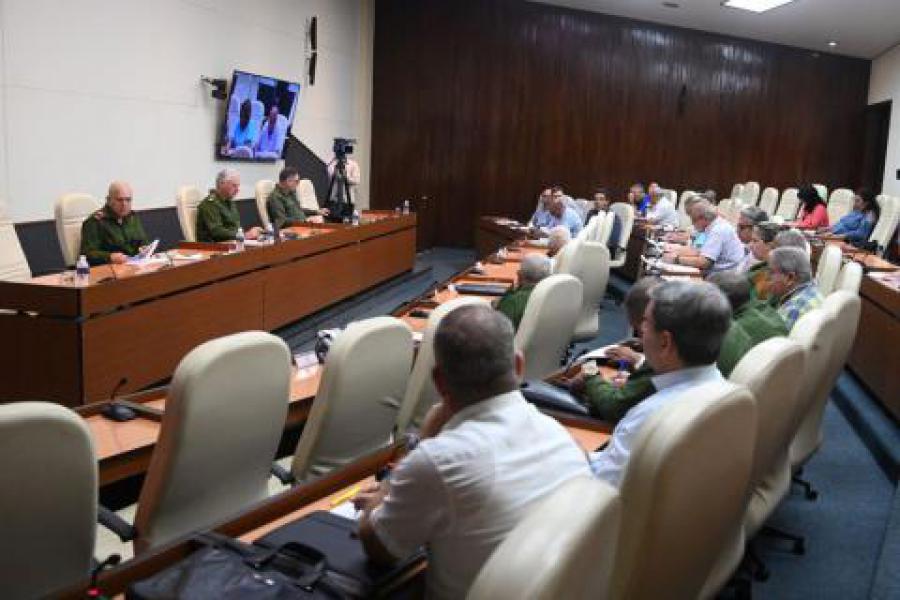Recognition for how work is being carried out throughout the country, to the harmony among all the leading factors; a highlight to how the Revolutionary Armed Forces and the Ministry of Interior have been incorporated into the recovery tasks; and especially praise to the people, to their discipline and effort amid these hours in which Cuba has been hit by several natural phenomena.
Such ideas were shared on Tuesday afternoon, from the Palace of the Revolution, by the President of the National Defense Council, Miguel Díaz-Canel Bermúdez, during the Check-up meeting that this higher State body has been holding daily to follow up on how the country's recovery is progressing after the two most recent cyclones, and after the eastern part of Cuba was affected by seismic activity.
Now the first battle has to do with erasing the traces of all those impacts, reflected the Head of State in a day of analysis that also included the Secretary of Organization of the Central Committee of the Communist Party, Roberto Morales Ojeda; as well as the Minister of the Interior of Cuba, Major General Lázaro Alberto Álvarez Casas; both members of the Political Bureau.
Immersed in its recovery work, Cuba keeps its alarms on, now, especially in the face of a new tropical wave that - as Celso Pazos Alberdi, general director of the National Institute of Meteorology, explained on Tuesday - will be moving close to the Central American coasts.
The expert explained that at the moment there is a strong anticyclone over the archipelago, which does not allow the new phenomenon to reach Cuban territory. The models concerning what may happen in the next hours are still divergent: according to Celso Pazos, some indicate a trajectory towards the coasts of Central America, and others point to a route towards the Gulf of Yucatan. Over the whole area, as stated by First Colonel Luis Angel Macareño, of the Civil Defense Agency, Cuba maintains permanent surveillance.
Seismic activity
During the check-up meeting, it was learned that 1,899 aftershocks have been quantified from the earthquake that erupted in the national territory last Sunday. Through a video conference, the country's leadership obtained updated information on the situation of the places affected by this natural phenomenon.
In Santiago de Cuba, the authorities have held exchanges with the population that experienced the impacts of the earthquake, while monitoring the damages caused to health and education infrastructures.
According to Eddie Galán Jiménez, a member of the Political and Ideological Bureau of Granma province, ten people were injured by the seismic activity, while 3,518 houses were affected. As for buildings of importance for the social life of the territory, 109 educational centers and 59 in the health sector were damaged.
When inquiring about the electricity service in the affected areas of Granma, President Díaz-Canel received the information that one hundred percent of the service has already been reestablished.“A tremendous job you did,” he said. To which the head of Energy and Mines, Vicente La O Ley, added the comment that the peasantry and the people helped a lot in this recovery work.
The water service in the municipality of Pilón, communications, and access roads. The Head of State inquired about these issues, and the answer was that everything had been recovered on these fronts.
Regarding the Cabo Cruz Lighthouse -which suffered severe damages in its upper part- the President spoke about the importance of designing a rigorous program to restore it.
There are specialized groups in the areas that lived the experience of the earthquake, because the states of mind, as it is logical, need that kind of help, as well as -as the Head of State reflected- constant communication.
The provinces affected by Hurricane Rafael
According to what the president of the Provincial Defense Council, Gladys Martínez Verdecia, informed at the check-up meeting, the province of Artemisa has recovered 41 percent of the centers affected by the passage of meteor Rafael.
Work is being carried out, said the party leader, in the collection of solid waste; at the time of the check-up, 222 people were protected throughout the province; 4.58 percent of the total number of customers had electricity service; and more than 400 generators were operating in vital services of the territory.
Other important data shared by Gladys Martínez: 51.2 percent of the population has access to water service; 17,324 houses have been affected; and 15,192 hectares of agriculture have been damaged. Although progress is being made in the clean-up, the leader acknowledged that “the debris situation is of great magnitude”.
As for the province of Mayabeque, the president of the Provincial Defense Council, Yuniasky Crespo Baquero, stated that 97 people are protected; that 93 percent of the territory's customers have electricity service; and that 92.2 percent are receiving water.
Díaz-Canel inquired about the progress of the sanitation works, to which Yuniasky replied that progress had been made. Batabanó, he said, is the most delayed municipality, although its progress is already over 60 percent.
In Havana, according to the president of the Provincial Defense Council, Liván Izquierdo Alonso, the number of people protected is 86; 76.2 percent of the population has water service; and 2,329 houses have been affected. On Tuesday, it was also reported that 98.37 percent of the population of the capital city already has electricity service.

